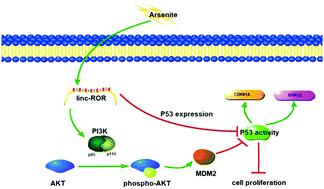当前位置:
X-MOL 学术
›
Metallomics
›
论文详情
Our official English website, www.x-mol.net, welcomes your
feedback! (Note: you will need to create a separate account there.)
Linc-ROR promotes arsenite-transformed keratinocyte proliferation by inhibiting P53 activity.
Metallomics ( IF 2.9 ) Pub Date : 2020-04-23 , DOI: 10.1039/d0mt00076k Xinyang Li 1 , Chao Zuo 1 , Mei Wu 1 , Zunzhen Zhang 1
Metallomics ( IF 2.9 ) Pub Date : 2020-04-23 , DOI: 10.1039/d0mt00076k Xinyang Li 1 , Chao Zuo 1 , Mei Wu 1 , Zunzhen Zhang 1
Affiliation

|
Linc-ROR is an oncogenic long non-coding RNA over-expressed in many kinds of cancer that promotes cancer cell proliferation. Arsenite is a determined carcinogen that increases the risk of skin cancer, but the carcinogenic mechanism of arsenite remains unclear. To explore whether and how linc-ROR plays a role in arsenite-induced carcinogenesis of skin cancer, we established arsenite-transformed keratinocyte HaCaT cells by exposing them to 1 μM arsenite for 50 passages. Then we examined the linc-ROR expression during the transformation and explored the effect of linc-ROR on the cell proliferation of arsenite-transformed HaCaT cells. We found that the linc-ROR level in HaCaT cells was gradually increased during arsenite-induced malignant transformation, and the activity of P53 was decreased, but the P53 expression was not significantly altered, indicating that linc-ROR may play a role in arsenite-induced HaCaT cell transformation that is associated with P53 activity but not P53 expression. We further demonstrated that linc-ROR down-regulation by siRNA significantly inhibited the cellular proliferation and restored P53 activity in arsenite-transformed HaCaT cells, suggesting that linc-ROR promotes proliferation of arsenite-transformed HaCaT cells by inhibiting P53 activity. Moreover, linc-ROR siRNA also down-regulated the PI3K/AKT pathway in arsenite-transformed HaCaT cells, and treatment with AKT inhibitor wortmannin restored P53 activity, implying that linc-ROR inhibits P53 activity by activating the PI3K/AKT pathway. Taken together, the present study shows that linc-ROR promotes arsenite-transformed keratinocyte proliferation by inhibiting P53 activity through activating PI3K/AKT, providing a novel carcinogenic mechanism of arsenite-induced skin cancer.
中文翻译:

Linc-ROR 通过抑制 P53 活性促进亚砷酸盐转化的角质形成细胞增殖。
Linc-ROR 是一种致癌的长链非编码 RNA,在多种癌症中过度表达,可促进癌细胞增殖。亚砷酸盐是一种确定的致癌物质,会增加患皮肤癌的风险,但亚砷酸盐的致癌机制尚不清楚。为了探索 linc-ROR 是否以及如何在亚砷酸盐诱导的皮肤癌癌变中起作用,我们通过将它们暴露于 1 μM 亚砷酸盐 50 代来建立亚砷酸盐转化的角质形成细胞 HaCaT 细胞。然后我们检查了转化过程中 linc-ROR 的表达,并探讨了 linc-ROR 对亚砷酸盐转化的 HaCaT 细胞增殖的影响。我们发现在亚砷酸盐诱导的恶性转化过程中,HaCaT 细胞中 linc-ROR 水平逐渐升高,P53活性降低,但P53表达没有显着改变,表明 linc-ROR 可能在亚砷酸盐诱导的 HaCaT 细胞转化中起作用,该转化与P53活性有关,但与P53表达无关。我们进一步证明,siRNA对linc-ROR的下调显着抑制了亚砷酸盐转化的HaCaT细胞的细胞增殖并恢复了P53活性,表明linc-ROR通过抑制P53活性来促进亚砷酸盐转化的HaCaT细胞的增殖。此外,linc-ROR siRNA 还下调亚砷酸盐转化的 HaCaT 细胞中的 PI3K/AKT 通路,用 AKT 抑制剂渥曼青霉素处理恢复P53活性,这意味着 linc-ROR 抑制P53通过激活 PI3K/AKT 通路来提高活性。总之,本研究表明,linc-ROR通过激活 PI3K/AKT抑制P53活性来促进亚砷酸盐转化的角质形成细胞增殖,为亚砷酸盐诱导的皮肤癌提供了一种新的致癌机制。
更新日期:2020-06-25
中文翻译:

Linc-ROR 通过抑制 P53 活性促进亚砷酸盐转化的角质形成细胞增殖。
Linc-ROR 是一种致癌的长链非编码 RNA,在多种癌症中过度表达,可促进癌细胞增殖。亚砷酸盐是一种确定的致癌物质,会增加患皮肤癌的风险,但亚砷酸盐的致癌机制尚不清楚。为了探索 linc-ROR 是否以及如何在亚砷酸盐诱导的皮肤癌癌变中起作用,我们通过将它们暴露于 1 μM 亚砷酸盐 50 代来建立亚砷酸盐转化的角质形成细胞 HaCaT 细胞。然后我们检查了转化过程中 linc-ROR 的表达,并探讨了 linc-ROR 对亚砷酸盐转化的 HaCaT 细胞增殖的影响。我们发现在亚砷酸盐诱导的恶性转化过程中,HaCaT 细胞中 linc-ROR 水平逐渐升高,P53活性降低,但P53表达没有显着改变,表明 linc-ROR 可能在亚砷酸盐诱导的 HaCaT 细胞转化中起作用,该转化与P53活性有关,但与P53表达无关。我们进一步证明,siRNA对linc-ROR的下调显着抑制了亚砷酸盐转化的HaCaT细胞的细胞增殖并恢复了P53活性,表明linc-ROR通过抑制P53活性来促进亚砷酸盐转化的HaCaT细胞的增殖。此外,linc-ROR siRNA 还下调亚砷酸盐转化的 HaCaT 细胞中的 PI3K/AKT 通路,用 AKT 抑制剂渥曼青霉素处理恢复P53活性,这意味着 linc-ROR 抑制P53通过激活 PI3K/AKT 通路来提高活性。总之,本研究表明,linc-ROR通过激活 PI3K/AKT抑制P53活性来促进亚砷酸盐转化的角质形成细胞增殖,为亚砷酸盐诱导的皮肤癌提供了一种新的致癌机制。











































 京公网安备 11010802027423号
京公网安备 11010802027423号